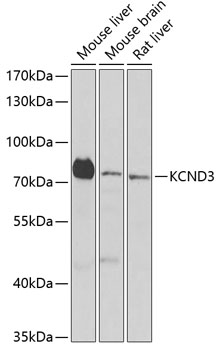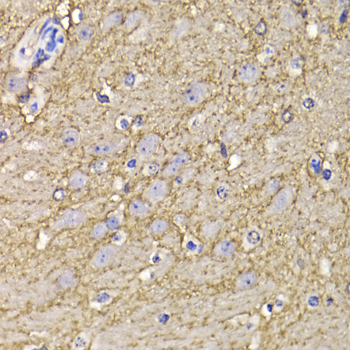Signal Transduction Antibodies 3
Anti-KCND3 Antibody (CAB6927)
- SKU:
- CAB6927
- Product Type:
- Antibody
- Reactivity:
- Human
- Reactivity:
- Mouse
- Reactivity:
- Rat
- Host Species:
- Rabbit
- Isotype:
- IgG
- Antibody Type:
- Polyclonal Antibody
- Research Area:
- Signal Transduction
Description
| Antibody Name: | Anti-KCND3 Antibody |
| Antibody SKU: | CAB6927 |
| Antibody Size: | 20uL, 50uL, 100uL |
| Application: | WB IHC |
| Reactivity: | Human, Mouse, Rat |
| Host Species: | Rabbit |
| Immunogen: | Recombinant fusion protein containing a sequence corresponding to amino acids 502-636 of human KCND3 (NP_751948.1). |
| Application: | WB IHC |
| Recommended Dilution: | WB 1:500 - 1:2000 IHC 1:50 - 1:200 |
| Reactivity: | Human, Mouse, Rat |
| Positive Samples: | Mouse liver, Mouse brain, Rat liver |
| Immunogen: | Recombinant fusion protein containing a sequence corresponding to amino acids 502-636 of human KCND3 (NP_751948.1). |
| Purification Method: | Affinity purification |
| Storage Buffer: | Store at -20'C. Avoid freeze / thaw cycles. Buffer: PBS with 0.02% sodium azide, 50% glycerol, pH7.3. |
| Isotype: | IgG |
| Sequence: | MESS MQNY PSTR SPSL SSHP GLTT TCCS RRSK KTTH LPNS NLPA TRLR SMQE LSTI HIQG SEQP SLTT SRSS LNLK ADDG LRPN CKTS QITT AIIS IPTP PALT PEGE SRPP PASP GPNT NIPS IASN VVKV SAL |
| Gene ID: | 3752 |
| Uniprot: | Q9UK17 |
| Cellular Location: | Cell membrane, Cell projection, Membrane, Multi-pass membrane protein, dendrite, sarcolemma |
| Calculated MW: | 71kDa/73kDa |
| Observed MW: | 73kDa |
| Synonyms: | KCND3, BRGDA9, KCND3L, KCND3S, KSHIVB, KV4.3, SCA19, SCA22 |
| Background: | Voltage-gated potassium (Kv) channels represent the most complex class of voltage-gated ion channels from both functional and structural standpoints. Their diverse functions include regulating neurotransmitter release, heart rate, insulin secretion, neuronal excitability, epithelial electrolyte transport, smooth muscle contraction, and cell volume. Four sequence-related potassium channel genes - shaker, shaw, shab, and shal - have been identified in Drosophila, and each has been shown to have human homolog(s). This gene encodes a member of the potassium channel, voltage-gated, shal-related subfamily, members of which form voltage-activated A-type potassium ion channels and are prominent in the repolarization phase of the action potential. This member includes two isoforms with different sizes, which are encoded by alternatively spliced transcript variants of this gene. |
| UniProt Protein Function: | Kv4.3: Pore-forming (alpha) subunit of voltage-gated rapidly inactivating A-type potassium channels. May contribute to I(To) current in heart and I(Sa) current in neurons. Channel properties are modulated by interactions with other alpha subunits and with regulatory subunits. KCND3 rare variants may confer risk for lethal ventricular arrhytmias and be associated with autopsy-negative sudden unexplained death syndrome (SUDS). Belongs to the potassium channel family. D (Shal) (TC 1.A.1.2) subfamily. Kv4.3/KCND3 sub-subfamily. 2 isoforms of the human protein are produced by alternative splicing. |
| UniProt Protein Details: | Protein type:Membrane protein, integral; Membrane protein, multi-pass; Channel, potassium Chromosomal Location of Human Ortholog: 1p13.3 Cellular Component: voltage-gated potassium channel complex; cell soma; dendrite; plasma membrane; sarcolemma Molecular Function:protein binding; metal ion binding; delayed rectifier potassium channel activity; A-type (transient outward) potassium channel activity Biological Process: synaptic transmission; potassium ion transport; protein homooligomerization Disease: Brugada Syndrome 9; Spinocerebellar Ataxia 19 |
| NCBI Summary: | Voltage-gated potassium (Kv) channels represent the most complex class of voltage-gated ion channels from both functional and structural standpoints. Their diverse functions include regulating neurotransmitter release, heart rate, insulin secretion, neuronal excitability, epithelial electrolyte transport, smooth muscle contraction, and cell volume. Four sequence-related potassium channel genes - shaker, shaw, shab, and shal - have been identified in Drosophila, and each has been shown to have human homolog(s). This gene encodes a member of the potassium channel, voltage-gated, shal-related subfamily, members of which form voltage-activated A-type potassium ion channels and are prominent in the repolarization phase of the action potential. This member includes two isoforms with different sizes, which are encoded by alternatively spliced transcript variants of this gene. [provided by RefSeq, Jul 2008] |
| UniProt Code: | Q9UK17 |
| NCBI GenInfo Identifier: | 92090984 |
| NCBI Gene ID: | 3752 |
| NCBI Accession: | Q9UK17.3 |
| UniProt Secondary Accession: | Q9UK17,O60576, O60577, Q14D71, Q5T0M0, Q9UH85, Q9UH86 Q9UK16, |
| UniProt Related Accession: | Q9UK17 |
| Molecular Weight: | 655 |
| NCBI Full Name: | Potassium voltage-gated channel subfamily D member 3 |
| NCBI Synonym Full Names: | potassium voltage-gated channel, Shal-related subfamily, member 3 |
| NCBI Official Symbol: | KCND3 |
| NCBI Official Synonym Symbols: | KV4.3; SCA19; SCA22; KCND3L; KCND3S; KSHIVB |
| NCBI Protein Information: | potassium voltage-gated channel subfamily D member 3; voltage-gated K+ channel; potassium ionic channel Kv4.3; sha1-related potassium channel Kv4.3; voltage-gated potassium channel subunit Kv4.3 |
| UniProt Protein Name: | Potassium voltage-gated channel subfamily D member 3 |
| UniProt Synonym Protein Names: | Voltage-gated potassium channel subunit Kv4.3 |
| Protein Family: | Potassium voltage-gated channel subfamily |
| UniProt Gene Name: | KCND3 |
| UniProt Entry Name: | KCND3_HUMAN |
View AllClose








